Bee (Sanskrit bha, A S. beó, Lat. apis), a large and natural family of the zoological order Hymenoptera, characterized by the plumose form of many of their hairs, by the large size of the basal segment of the foot, which is always elongate and in the hindmost limb sometimes as broad as the shin, and by the development of a “tongue” for sucking liquid food; this organ has been variously interpreted as the true insectan tongue (hypo-pharynx) or as a ligula formed by fused portions of the second maxillae (probably the latter).
Bees are specialized in correspondence with the flowers from which they draw the bulk of their food supply, the flexible tongue being used for sucking nectar, the plumed hairs and the modified legs (fig. 7) for gathering pollen. These floral products which form the food of bees and of their larvae, are in most cases collected and stored by the industrious insects; but some genera of bees act as inquilines or “cuckoo-parasites,” laying their eggs in the nests of other bees, so that their larvae may feed at the expense of the rightful owners of the nest. In a few cases, the parasitic bee-grub devours not only the food-supply, but also the larva of its host.
Solitary and Social Bees.—Many genera of bees are represented, like most other insects, by ordinary males and females, each female constructing a nest formed of several chambers (“cells”) and storing in each chamber a supply of food for the grub to be hatched from the egg that she lays therein. Such bees, although a number of individuals often make their nests close together, are termed “solitary,” their communities differing in nature from those of the “social” bees, among which there are two kinds of females—the normal fertile females or “queens,” and those specially modified females with undeveloped ovaries (see fig. 6) that are called “workers” (fig. 1). The workers are the earliest developed offspring of the queen, and it is their associated work which renders possible the rise of an insect state—a state which evidently has its origin in the family. It is interesting to trace various stages in the elaboration of the bee-society. Among the humble-bees (Bombus) the workers help the queen, who takes her share in the duties of the nest; the distinction between queen and workers is therefore less absolute than in the hive-bees (Apis), whose queen, relieved of all nursing and building cares by the workers, devotes her whole energies to egg-laying. The division of labour among the two castes of female becomes therefore most complete in the most highly organized society.
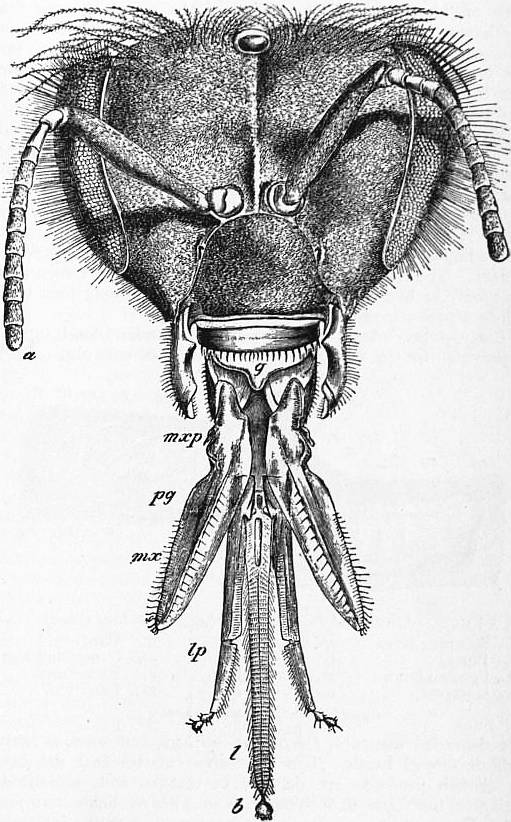 |
|
| Fig. 2.—Head and Appendages of Honey-bee (Apis). | |
a, Antenna or feeler. g, Epipharynx. mxp, Maxillary palp. pg, Opposite to galeae of 2nd maxillae (labium). |
mx, 1st maxilla. lp, Labial palp. l, Ligula or “tongue.” b, Bouton or spoon of the ligula. |
| (From Frank R. Cheshire’s Bees and Bee-keeping.) | |
Structure.—Details of the structure of bees are given in the article Hymenoptera. The feelers (fig. 2, a) are divided into “scape” and “flagellum” as in the ants, and the mandibles vary greatly in size and sharpness in different genera. The proboscis or “tongue” (fig. 2, l) is a hollow organ enclosing an outgrowth of the body-cavity which is filled with fluid, and with its flexible under-surface capable of invagination or protrusion. Along this surface stretches a groove which is surrounded by thickened cuticle and practically formed into a tube by numerous fine hairs. Along this channel the nectar is drawn into the pharynx and passes, mixed with saliva, into the crop or “honey-bag”; the action of the saliva changes the saccharose into dextrose and levulose, and the nectar becomes honey, which the bee regurgitates for storage in the cells or for the feeding of the grubs. The sting (fig. 6, pg, st.) of female bees is usually highly specialized, but in a few genera it is reduced and useless.
Many modifications in details of structure may be observed within the family. The tongue is bifid at the tip in a few genera; usually it is pointed and varies greatly in length, being comparatively short in Andrena, long in the humble-bees (Bombus), and longest in Euglossa, a tropical American genus of solitary bees. The legs, which are so highly modified as pollen-carriers in the higher bees, are comparatively simple in certain primitive genera. The hairy covering, so notable in the hive-bee and especially in humble-bees, is greatly reduced among bees that follow a parasitic mode of life.
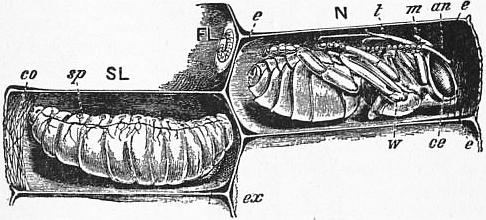 |
||
| Fig. 3.—Larva and Pupa of Apis. | ||
SL, Spinning larva. N, Pupa. FL, Feeding larva. co, Cocoon. |
sp, Spiracles. t, “Tongue.” m, Mandible. an, Antenna |
w, Wing. ce, Compound Eye. e, Excrement. ex, Exuvium. |
| (From Cheshire’s Bees and Bee-keeping.) | ||
Early stages.—As is usual where an abundant food supply is provided for the young insects, the larvae of bees (fig. 3, SL.) are degraded maggots; they have no legs, but possess fairly well-developed heads. The successive cuticles that are cast as growth proceeds are delicate in texture and sometimes separate from the underlying cuticle without being stripped off. The maggots may pass no excrement from the intestine until they have eaten all their store of food. When fully grown the final larval cuticle is shed, and the “free” pupa (fig. 3, N) revealed. The larvae of some bees spin cocoons (fig. 3, co) before pupation.
Nests of Solitary Bees.—Bees of different genera vary considerably in the site and arrangement of their nests. Many—like the common “solitary” bees Halictus and Andrena—burrow in the ground; the holes of species of Andrena are commonly seen in springtime opening on sandy banks, grassy lawns or gravel paths. Our knowledge of such bees is due to the observations of F. Smith, H. Friese, C. Verhoeff and others. The nest may be simple, or, more frequently, a complex excavation, cells opening off from the entrance or from a main passage. Sometimes the passage is the conjoint work of many bees whose cells are grouped along it at convenient distances apart. Other bees, the species of Osmia for example, choose the hollow stem of a bramble or other shrub, the female forming a linear series of cells in each of which an egg is laid and a supply of food stored up. J.H. Fabre has found that in the nests of some species of Osmia the young bee developed in the first-formed cell, if (as often happens) she emerges from her cocoon before the inmates of the later cells, will try to work her way round these or to bite a lateral hole through the bramble shoot; should she fail to do this, she will wait for the emergence of her sisters and not make her escape at the price of injury to them. But when Fabre substituted dead individuals of her own species or live larvae of another genus, the Osmia had no scruple in destroying them, so as to bite her way out to air and liberty.
The leaf-cutter bees (Megachile)—which differ from Andrena and Halictus and agree with Osmia, Apis and Bombus in having elongate tongues—cut neat circular disks from leaves, using them for lining the cells of their underground nests. The carpenter-bees (Xylocopa and allied genera), unrepresented in the British Islands, though widely distributed in warmer countries, make their nests in dry wood. The habits of X. violacea, the commonest European species, were minutely described in the 18th century in one of R.A.F. de Réaumur’s memoirs. This bee excavates several parallel galleries to which access is gained by a cylindrical hole. In the galleries are situated the cells, separated from one another by transverse partitions, which are formed of chips of wood, cemented by the saliva of the bee.
Among the solitary bees none has more remarkable nesting habits than the mason bee (Chalicodoma) represented in the south of France and described at length by Fabre. The female constructs on a stone a series of cells, built of cement, which she compounds of particles of earth, minute stones and her own saliva. Each cell is provided with a store of honey and pollen beside which an egg is laid; and after eight or nine cells have been successively built and stored, the whole is covered by a dome-like mass of cement. Fabre found that a Chalicodoma removed to a distance of 4 kilometres from the nest that she was building, found her way back without difficulty to the exact spot. But if the nest were removed but a few yards from its former position, the bee seemed no longer able to recognize it, sometimes passing over it, or even into the unfinished cell, and then leaving it to visit again uselessly the place whence it had been moved. She would accept willingly, however, another nest placed in the exact spot where her own had been. If the unfinished cell in the old nest had been only just begun, while that in the substituted nest were nearly completed, the bee would add so much material as to make the cell much larger than the normal size, her instinct evidently being to do a certain amount of building work before filling the cell with food. The food, too, is always placed in the cell after a fixed routine—first honey disgorged from the mouth, then pollen brushed off the hairs beneath the body (fig. 7, c) after which the two substances are mixed into a paste.
Inquilines and Parasites.—The working bees, such as have been mentioned, are victimized by bees of other genera, which throw upon the industrious the task of providing for the young of the idle. The nests of Andrena, for example, are haunted by the black and yellow species of Nomada, whose females lay their eggs in the food provided for the larva of the Andrena. According to H. Friese, the relations between the host and the inquiline are quite friendly, and the insects if they meet in the nest-galleries courteously get out of each other’s way. D. Sharp, in commenting on this strange behaviour, points out that the host can have no idea why the inquiline haunts her nest. “Why then should the Andrena feel alarm? If the species of Nomada attack the species of Andrena too much, it brings about the destruction of its own species more certainly than that of the Andrena.”
More violent in its methods is the larva of a Stelis, whose operations in the nest of Osmia leucomelana have been studied by Verhoeff. The female Stelis lays her eggs earlier than the Osmia, and towards the bottom of the food-mass; the egg of the Osmia is laid later, and on the surface of the food. Hence the two eggs are at opposite ends of the food, and both larvae feed for a time without conflict, but the Stelis, being the older, is the larger of the two. Finally the parasitic larva attacks the Osmia, and digging its mandibles into its victim’s head kills and eats it, taking from one to two days for the completion of the repast.
 |
| Fig. 4.—Under Side of Worker, carrying Wax Scales. |
| (From Cheshire’s Bees and Bee-keeping.) |
Social Bees.—The bees hitherto described are “solitary,” all the individuals being either males or unmodified females. The most highly developed of the long-tongued bees are “social” species, in which the females are differentiated into egg-laying queens and (usually) infertile “workers” (fig. 6). Verhoeff has discussed the rise of the “social” from the “solitary” condition, and points out that for the formation of an insect community three conditions are necessary—a nest large enough for a number of individuals, a close grouping of the cells, and an association between mother and daughters in the winged state. For the fulfilment of this last condition, the older insects of the new generation must emerge from the cells while the mother is still occupied with the younger eggs or larvae. One species of Halictus nearly reaches the desired stage; but the first young bees to appear in the perfect state are males, and when the females emerge the mother dies.
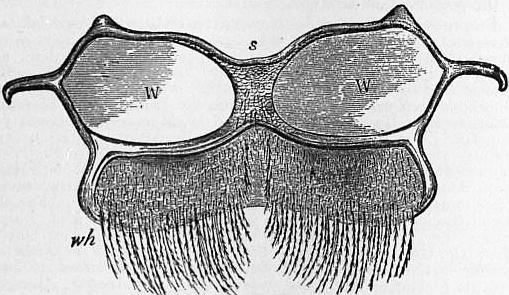 |
| Fig. 5.—Abdominal Plate (worker of Apis), under side, third segment. W, wax-yielding surface, covering true gland; s, septem, or carina; wh, webbed hairs. |
| (From Cheshire’s Bees and Bee-keeping.) |
Among the social bees the mother and daughter-insects co-operate, and they differ from the “solitary” groups in the nature of their nest, the cells (fig. 25) of which are formed of wax secreted by special glands (fig. 5) in the bee’s abdomen, the wax being pressed out between the segmental sclerites in the form of plates (fig. 4), which are worked by the legs (fig. 7) and jaws into the requisite shape. In our well-known hive-bee (Apis) and humble-bees (Bombus) the wax glands are ventral in position, but in the “stingless” bees of the tropics (Trigona and Melipona) they are dorsal. A colony of humble-bees is started in spring by a female “queen” which has survived the winter. She starts her nest underground or in a surface depression, forming a number of waxen cells, roughly globular in shape and arranged irregularly. The young females (“workers”) that develop from the eggs laid in these early cells assist the queen by building fresh cells and gathering food for storage therein. The queen may be altogether relieved of the work of the nest as the season advances, so that she can devote all her energies to egg-laying, and the colony grows rapidly. The distinction between queen and worker is not always clear among humble-bees, the female insects varying in size and in the development of their ovaries. If any mishap befall the queen, the workers can sometimes keep the community from dying out. In autumn males are produced, as well as young queens. The community is broken up on the approach of winter, the males and workers perish, and the young queens after hibernation start fresh nests in the succeeding year.
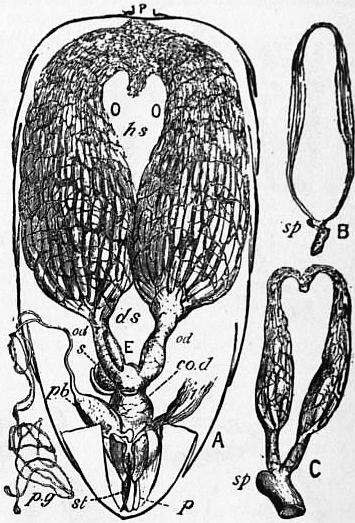 |
|
| Fig. 6.—Ovaries of Queen and Workers (Apis). | |
A, Abdomen of queen, under side. P, Petiole. o, o, Ovaries. hs, Position filled by honey-sack. ds, Position through which digestive system passes. od, Oviduct. co.d, Vagina. E, Egg-passing oviduct. s, Spermatheca. |
i. Intestine. pb, Poison bag. pg, Poison gland. st, Sting. p, “Palps” or “feelers” of sting. B, Rudimentary ovaries of ordinary worker. sp, Rudimentary spermatheca. C, Partially developed ovaries of fertile worker. sp, Rudimentary spermatheca. |
| (From Cheshire’s Bees and Bee-keeping.) | |
The appearance of the heavy-bodied hairy Bombi is well known. They are closely “mimicked” by bees of the genus Psithyrus, which often share their nests. These Psithyri have no pollen-carrying structures on the legs and their grubs are dependent for their food-supply on the labours of the Bombi, though, according to E. Hoffer’s observations, it seems that the female Psithyrus builds her own cells. The colonies of Bombus illustrate the rise of the inquiline habit. Many of the species are very variable and have been differentiated into races or varieties. F.W.L. Sladen states that a queen belonging to the virginalis form of Bombus terrestris often invades a nest belonging to the lucorum form, kills the rightful queen, and takes possession of the nest, getting the lucorum workers to rear her young. In the nests of Bombi are found various beetle larvae that live as inquilines or parasites, and also maggots of drone-flies (Volucella), which act as scavengers; the Volucella-fly is usually a “mimic” of the Bombus, whose nest she invades.
The “stingless” bees (Trigona) of the tropics have the parts of the sting reduced and useless for piercing. As though to compensate for the loss of this means of defence, the mandibles are very powerful, and some of the bees construct tubular entrances to the nest with a series of constrictions easy to hold against an enemy. The habits of the Brazilian species of these bees have been described in detail by H. von Jhering, who points out that their wax glands are dorsal in position, not ventral as in Bombus and Apis.
With Apis, the genus of the hive-bee, we come to the most highly-specialized members of the family—better known, perhaps than any other insects, on account of the long domestication of many of the species or races. In Apis the workers differ structurally from the queen, who neither builds cells, gathers food, nor tends brood, and is therefore without the special organs adapted for those functions which are possessed in perfection by the workers. The differentiation of queen and workers is correlated with the habit of storing food supplies, and the consequent permanence of the community, which finds relief for its surplus population by sending off a swarm, consisting of a queen and a number of workers, so that the new community is already specialized both for reproduction and for labour.
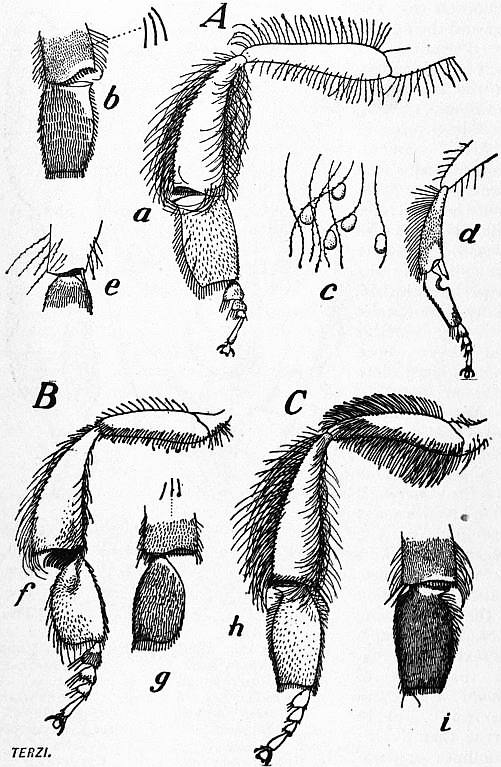 |
|
| Fig. 7.—Modifications in the Legs of Bees. | |
A. a-d, Hive-bee (Apis). B. f-g, Stingless bee (Melipona). C. h-i, Humble-bee (Bombus). a, f, h, Outer view of hind-leg. b, g, i, Inner view. |
d, Fore-leg of Apis showing notch in tarsal segment for cleaning feeler. e, Tip of intermediate shin with spur. c, Feathered hairs with pollen grains, magnified. |
| (After Riley, Insect Life (U.S. Dept. Agr.), vol. 6.) | |
The workers of Apis may be capable (fig. 6, C) of laying eggs—necessarily unfertilized—which always give rise to males (“drones”), and, since the researches of J. Dzierzon (1811-1906) in 1848, it has been believed that the queen bee lays fertilized eggs in cells appropriate for the rearing of queens or workers, and unfertilized eggs in “drone-cells,” virgin reproduction or parthenogenesis being therefore a normal factor in the life of these insects. F. Dickel and others have lately claimed that fertilized eggs can give rise to either queens, workers or males, according to the food supplied to the larvae and the influence of supposed “sex-producing glands” possessed by the nurse-workers. Dickel states that a German male bee mated with a female of the Italian race transmits distinct paternal characters to hybrid male offspring. A. Weismann, however, doubts these conclusions, and having found a spermaster in every one of the eggs that he examined from worker-cells, and in only one out of 272 eggs taken from drone-cells, he supports Dzierzon’s view, explaining the single exception mentioned above as a mistake of the queen, she having laid inadvertently this single fertilized egg in a drone instead of in a worker cell.
The cells of the honeycomb of Apis are usually hexagonal in form, and arranged in two series back to back (figs. 3, 25). Some of these cells are used for storage, others for the rearing of brood. The cells in which workers are reared are smaller than those appropriate for the rearing of drones, while the “royal cells,” in which the young queens are developed, are large in size and of an irregular oval in form (fig. 25). It is believed that from the nature of the cell in which she is ovipositing, the queen derives a reflex impulse to lay the appropriate egg—fertilized in the queen or worker cell, unfertilized in the drone cell, as previously mentioned. Whether the fertilized egg shall develop into a queen or a worker depends upon the nature of the food. All young grubs are at first fed with a specially nutritious food, discharged from the worker’s stomach, to which is added a digestive secretion derived from special salivary glands in the worker’s head. If this “royal jelly” continue to be given to the grub throughout its life, it will grow into a queen; if the ordinary mixture of honey and digested pollen be substituted, as is usually the case from the fourth day, the grub will become a worker. The workers, who control the polity of the hive (the “queen” being exceedingly “limited” in her monarchy), arrange if possible that young queens shall develop only when the population of the hive has become so congested that it is desirable to send off a swarm. When a young queen has emerged, she stings her royal sisters (still in the pupal stage) to death. Previous to the emergence of the young queen, the old queen, prevented by the workers from attacking her daughters, has led off a swarm to find a new home elsewhere. The young queen, left in the old home, mounts high into the air for her nuptial flight, and then returns to the hive and her duties of egg-laying. The number of workers increases largely during the summer, and so hard do the insects work that the life of an individual may last only a few weeks. On the approach of winter the males, having no further function to perform for the community, are refused food-supplies by the workers, and are either excluded or banished from the hive to perish. Such ruthless habits of the bee-commonwealth, no less than the altruistic labours of the workers, are adapted for the survival and dominance of the species. The struggle for life may deal hardly with the individual, but it results—to quote Darwin’s well-known title—in “the preservation of favoured races.”
Bibliography.—More has been written on bees, and especially on the genus Apis, than on any other group of insects. The classical observations of Réaumur Mémoires pour servir à l’histoire des insectes, vols. v., vi. (Paris, 1740-1742) and F. Huber’s Nouvelles observations sur les abeilles (Genéve, 1792) will never be forgotten; they have been matched in recent times by J.H. Fabre’s Souvenirs entomologiques (Paris, 1879-1891); and M. Maeterlinck’s poetic yet scientific La vie des abeilles (Paris, 1901). Among writers on the solitary and parasitic species may be specially mentioned F. Smith, Hymenoptera in the British Museum (London, 1853-1859); H. Friese, Zool. Jahrb. Syst., iv. (1891) J. Pérez, Actes Soc. Bordeaux, xlviii. (1895); and C. Verhoeff, Zool. Jahrb. Syst., vi. (1892). For the social species we have valuable papers by E. Hoffer, Mitt. Naturwissen. Ver. Steiermark, xxxi. (1881); H. von Jhering, Zool. Jahrb. Syst., xix. (1903); and others. For recent controversy on parthenogenesis in the hive bee, see J. Pérez, Ann. Sci. Nat. Zool. (6), vii. (1878); F. Dickel, Zool. Anz., xxv. (1901), and Anatom. Anzeiger, xix. (1902); A. Petrunkevich, Zoolog. Jahrb. Anat., xiv. (1901); and A. Weismann, Anatom. Anzeiger, xviii. (1901). F.R. Cheshire’s Bees and Bee-keeping (London, 1885-1888), and T.W. Cowan’s Honey Bee (2nd ed., 1904), are invaluable to the naturalist, and contain extensive bibliographies of Apis. D. Sharp’s summary in the Cambridge Natural History, vol. vi., should be consulted for further information on bees generally. British bees are described in the catalogues of Smith, mentioned above, and by E. Saunders, The Hymenoptera of the British Islands (London, 1896).
Bee-Keeping
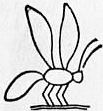 |
| Fig. 8.—Sign of the king of Lower Egypt; from the coffin of Mykerinos, 3633 B.C. (British Museum). |
Bee-keeping, or the cultivation of the honey-bee as a source of income to those who practise it, is known to have existed from the most ancient times. Poets, philosophers, historians and naturalists (among whom may be mentioned Virgil, Aristotle, Cicero and Pliny) have eulogized the bee as unique among insects, endowed by nature with wondrous gifts beneficial to mankind in a greater degree than any other creature of the insect world. We are told that some of these ancient scientists passed years of their lives studying the wonders of bee-life, and left accurate records of their observations, which on many points agree with the investigations of later observers. As a forcible illustration of the manner in which a colony of bees was recognized as the embodiment of government by a chief or ruler, in the earliest times of which there is any existing record, it may be mentioned that on the sarcophagus containing the mummified remains of Mykerinos (now in the British Museum and dating back 3633 years B.C.) will be found a hieroglyphic bee, (fig. 8) representing the king of Lower Egypt.
In dealing with the practical side of bee-keeping as now understood, it may be said that, compared with the methods in vogue during the first decade of the 19th century, or even within the memory of men still living at the beginning of the 20th, it is as the modern locomotive to the stagecoach of a previous generation. Almost everything connected with bee-craft has been revolutionized, and apiculture, instead of being classed with such homely rural occupations as that of the country housewife who carries a few eggs weekly to the market-town in her basket, is to-day regarded in many countries as a pursuit of considerable importance. Queen-rearing. Remarkable progress has also been made in the art of queen-rearing, and in improving the common or native bee by judicious crossing with the best foreign races, selected mainly for hardiness, working qualities and the prolific capacity of their queens. American bee-breeders are conspicuous in this respect, extensive apiaries being exclusively devoted to the business of rearing queens by the thousand for sale and export.
On the European continent queen-rearing apiaries are plentiful, but less attention is paid there to hybridizing than to keeping the respective races pure. In England also, some bee-keepers include queen-rearing as part of their business, while one large apiary on the south coast is exclusively devoted to the rearing of queen bees on the latest scientific system, and to breeding by selection from such races as are most suited to the exceptional climatic conditions of the country.
Extensive apiaries have been established on the American continent, some containing from 2000 to 3500 colonies of bees, and in these honey is harvested in hundreds of tons yearly. The magnitude of the bee industry in the United States may be judged from the fact of a single bee-farmer located in California having harvested from 150,000 ℔ of honey in one year from 2000 stocks of bees, and, as an instance of the enormous weight of honey obtainable from good hives in that favoured region, the same farmer secured 60,000 ℔ of comb-honey in one season from his best 300 colonies. This is probably the maximum, and the hives were necessarily located in separate apiaries some few miles apart in order to avoid the evils of overstocking, but all in the midst of thousands of acres of honey-yielding flowers. Results like the above compared with those of the skeppist bee-keeper of former days, who was well pleased with an average of 20 to 25 ℔ per hive, may be regarded as wonderful, but Honey as food. they are matters of fact. The consumption of honey as an article of food has also largely increased of late years; a recent computation shows that from 100 to 125 million ℔ of honey, representing a money value of from eight to ten million dollars, is consumed annually in the United States alone. Many of the larger bee-farmers of the United States of America and Canada harvest from 50,000 to 60,000 ℔ of honey in a single season, and some of them sell the whole crop direct to consumers.
It is a notable fact that in the United States, Canada, Australia, New Zealand, and indeed all English-speaking countries outside the United Kingdom, honey is far more extensively used than it is there as an article of daily food. The natural result of this is that the trade in honey is conducted, in those countries, on entirely different lines from those followed in the British Isles, where honey production as an occupation has, until quite recent years, been regarded as too insignificant for official notice in any State aid for bee-keeping. form. The value of the bee industry is now recognized, however, by the British government as worthy of state aid, in the promotion of technical instruction connected with agriculture. On the American continent apiculture is officially recognized by the respective states’ governments; and by the federal government at Washington it is taken into account as a section of the Agricultural Department, with fully equipped experimental apiaries and qualified professors engaged therein for educational work. In several Canadian provinces also, the public funds are used in promoting the bee industry in various ways, mainly in combating the bee-disease known as “foul brood.” In New Zealand the government of the colony has displayed the most praiseworthy earnestness and vigour in promoting apiculture. State-aided apiaries have been established under the supervision of a skilled bee-keeper, who travels over the colony giving instruction in practical bee-work at the public schools, and forming classes at various centres where pupils are taught bee-keeping in all its branches.
In Europe similar progress is observable; technical schools, with well-equipped apiaries attached, are supported by the state, and in them the science and practice of modern bee-keeping is taught free by scientists and practical experts. Institutions of this kind have been established in Germany, Russia, Switzerland and elsewhere, all tending in the same direction, viz. the cultivation of the honey-bee as an appreciable source of income to the farmer, the peasant cultivator, and dwellers in districts where bee-forage is abundant and, if unvisited by the bee, lies wasting its sweetness on the desert air. It may be safely said that the value of the bee to the fruit-grower and the market-gardener has been proved beyond dispute; and the technical instruction now afforded by county councils in the rural Value of bees as fertilizers. districts of England has an appreciable effect. In proof thereof, we may quote the case of an extensive grower in the midland counties—sending fruit to the London market in tons—whose crop of gooseberries increased nearly fourfold after establishing a number of stocks of bees in close proximity to the gooseberry bushes. The fruit orchards and raspberry fields of Kent are also known to be greatly benefited by the numerous colonies of bees owned by more than 3000 bee-keepers in the county. The important part played by the bee in the economy of nature as a fertilizer is shown in fig. 9.
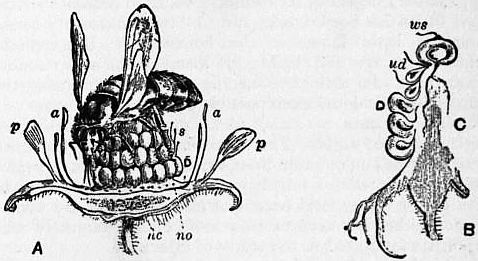 |
|
| Fig. 9.—A, Raspberry (Rubus idaeus, order Rosaceae), being fertilized. B, Cross section. | |
A, Flower. p, p, Petals. a, a, Anthers. s, Stigma. no, Nectary openings. nc, Nectar cells. D, Drupels. |
B, Section through core, or torus (C) and drupels (D). ud, Unfertilized drupel. ws, Withered stigma. |
| (From Cheshire’s Bees and Bee-keeping, Scientific and Practical.) | |
In the United Kingdom the prevailing conditions, climatic and otherwise, with regard to apiculture—as well as the lack of sufficient natural bee-forage for large apiaries—are such as to preclude the possibility of establishing apiaries on a scale comparable with those located in less confined lands. On the other hand, even in England the value of bee-keeping is worthy of recognition as a minor industry connected with such items of agriculture as fruit-growing, market-gardening or poultry-raising. The fact that British honey is second to none for quality, and that the British market is eagerly sought by the bee-keepers of other nationalities, has of late impressed itself on the minds of thinking men. Moreover, their views are confirmed by the constant references to bees and the profits obtainable from bee-keeping in the leading papers on all sides. This newly-aroused interest in the subject is no doubt to a large extent fostered by the grants in aid of technical instruction afforded by Bee-keepers’ associations. county councils in rural districts. The British Bee-keepers’ Association (instituted in 1874) has been untiring in its efforts to raise the standard of efficiency among those who are desirous of qualifying as experts and teachers of bee-keeping on modern methods. This body had for its first president the distinguished naturalist Sir John Lubbock (Lord Avebury). Subsequently the baroness Burdett-Coutts accepted the office in the year 1878, and was re-elected annually until her death in 1906. During this time she presided at its meetings and took an active part in its work, until advancing years prevented her attendance, but her interest in the welfare of the association was maintained to the last. Branch societies of bee-keepers were established throughout the English counties, mainly by the efforts of the parent body in London, with the object of securing co-operation in promoting the sale Bee and honey shows. of honey, and showing the most modern methods of producing it in its most attractive form at exhibitions held for the purpose. Nearly the whole of these county societies affiliated with the central association, paying an affiliation fee yearly, and receiving in return the silver medal, bronze medal and certificate of the association, to be offered as prizes for competition at the annual county shows. Other advantages are given in connexion with the qualifying of experts, &c., while nearly all the county associations in the United Kingdom employ qualified men who visit members in spring and autumn for the purpose of examining hives and giving advice on bee management to those needing it. Another Honey labels. advantage of membership is the use of a “county label” for affixing to each section of honey in comb, or jar of extracted honey, offered for sale by members. These labels are numbered consecutively, and thus afford a guarantee of the genuineness and quality of the honey, the label enabling purchasers to trace the producer if needed. The British Bee-keepers’ Association is an entirely philanthropic body, the only object of its members being to promote all that is good in British bee-keeping, and to “teach humanity to that industrious little labourer, the honey-bee.” Bee-appliance manufacturers are not eligible for membership of its council, nor are those who make bee-keeping their main business; thus no professional jealousies can possibly arise. In this respect the association appears to stand alone among the bee-keepers’ societies of the world. There are many equally beneficial societies, framed on different lines, existing in Germany, France, Russia and Switzerland, but they are mainly co-operative bodies instituted for the general benefit of members, who are without exception either bee-keepers on a more or less extensive scale, or scientists interested in the study of insect life.
The bee-keepers’ associations of the United States, Canada and most of the British colonies, are—like those last mentioned above—formed for the sole and laudable purpose of promoting the business interests of their members, the latter being either bee-farmers or bee-appliance manufacturers. Thus they make no pretension of any but business discussions at their conferences, and much benefit to all concerned follows as a matter of course. In fact, we find enthusiastic bee-men and women travelling several hundreds of miles and devoting time, money and labour in attending conferences of bee-keepers in America, while the proceedings usually last for several days and are largely attended. The extent of the industry compared with that of Great Britain is so great that it fully accounts for the difference in procedure of the respective associations.
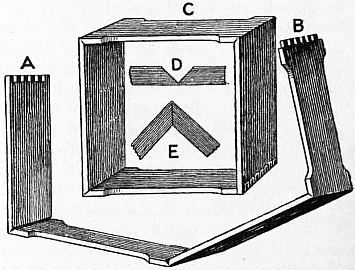 |
| Fig. 10.—“1-℔ section” wooden box for holding Comb-honey. |
| (Redrawn from the A B C of Bee Culture, published by the A. I. Root Co. Medina, Ohio, U.S.A.) |
As a natural consequence of this activity, the trade in bee-appliance making has assumed enormous proportions in the United States, where extensive factories have been established; one firm—employing over 500 hands, The bee-appliance trade. and using electric-power machinery of the most modern type—being devoted entirely to the manufacture of bee-goods and apiarian requisites. From this establishment alone the yearly output is about 25,000 bee-hives, and upwards of 100 millions of the small wooden boxes used for holding comb-honey. The most generally approved form of this box is known as the “1-℔ section,” made from a strip of wood ½ in. thick, 2 in. wide, and of such length that when folded by joining the morticed and tenoned ends A B (fig. 10) it forms the section of box C, measuring 4¼″ × 4½″ × 2″ when complete, and holds about 1 ℔ of comb-honey when filled by the bees and ready for table use. The V-shaped groove D (cut across and partly through the wood) shows the joint when in the flat, and E the same joint when closed for use. All the section boxes used in the United Kingdom are made in the U.S.A or in Canada from the timber known as basswood, no native wood being suitable for the purpose.
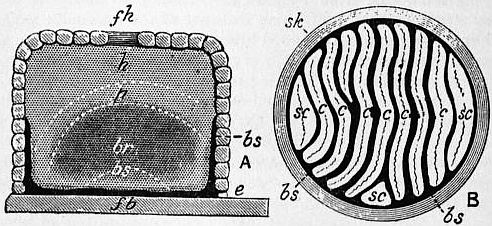 |
||
| Fig. 11.—Straw skep in section, showing arrangement of Combs. | ||
A, Vertical section. fb, Floor board. e, Entrance. br, Brood p, Pollen. |
h, Honey. fh, Feeding hole. bs, bs, Bee spaces. B, Horizontal section. |
sk, Skep-side. c, c, Combs. sc, sc, Store combs. bs, bs, Bee spaces. |
| (from Cheshire’s Bees and Bee-keeping, Scientific and Practical.) | ||
Development of the Movable-frame Hive—The dome-shaped straw skep of our forefathers may be regarded as the typical bee-hive of all time and of all civilized countries; indeed, it may with truth be said that as a healthy The straw skep. and convenient home for the honey-bee it has no equal. A swarm of bees hived in a straw skep, the picturesque little domicile known the world over as the personification of industry, will furnish their home with waxen combs in form and shape so admirably adapted to their requirements as to need no improvement by man. Why the circular form was chosen for the skep need not be inquired into, beyond saying that its shape conforms to that of a swarm, as the bees usually hang clustered on the branch of a neighbouring tree or bush after issuing from the parent hive. Fig 11 shows a straw skep in section, and explains itself as illustrating the admirable way in which the bees furnish their dwelling. The vertical section (A) shows the lower portion of the combs devoted to brood-rearing, the higher and thicker combs being reserved for honey, and midway between the brood and food is stored the pollen required for mixing with honey in feeding the larvae. It will be seen how well the upper part of the combs are fitted for bearing the weight of stores they contain, and how the lower portion allows the bees to cluster around the tender larvae and thus maintain the warmth necessary during its metamorphosis from the egg to the perfect insect. The horizontal section (B) with equal clearness demonstrates the bee’s ingenuity in economizing space, showing how the outer combs are used exclusively for stores, and, as such, may be built of varying thickness as more or less storage room is required. The straw skep has, however, the irredeemable fault of fixed combs, The movable-frame hive. and the gradual development of the movable-frame hive of today may be said to have first appeared in 1789 with the leaf-hive of Huber, so called from its opening like the leaves of a book. Prior to that date wooden box-hives of various shapes had been adopted by advanced bee-masters anxious to increase their output of honey, and by enthusiastic naturalists desirous of studying and investigating the wonders of bee-life apart from the utilitarian standpoint. Foremost among the latter was the distinguished Swiss naturalist and bee-keeper, François Huber, who was led to construct the leaf-hive bearing his name after experimenting with a single comb observatory hive recommended by Réaumur. Huber found that although he could induce swarms to occupy the glass-sided single frame advised by Réaumur, if the frame was fitted with ready-built pieces of comb patched together before hiving the swarm, the experiment was successful, while if left to themselves the bees built small combs across the space between the sheets of glass, and the desired inspection from the outside was thus rendered impossible. He also gathered that the abnormal conditions forced upon the bees by a ready-built single comb might so turn aside their natural instincts as to render his investigations less trustworthy than if conducted under perfectly natural conditions; so, in order to remove all doubt, he decided to have a series of wooden frames made, measuring 12 in. sq., each of rather more than the ordinary width allowed for brood-combs. These frames were numbered consecutively 1 to 12, and hinged together as shown in fig. 12 (h, A). In this way the frames of comb could be opened for inspection like a book, while when closed the bees clustered together as in an ordinary hive. Ten of these frames had a small piece of comb fixed to the top-bar in each, supported (temporarily) by a thin lath wedged up with pegs at side, the latter being removed when the comb had been made secure by the bees. When closed, the ten frames, together with the two outside ones (fitted with squares of glass for inspection), which represent the covers of the book, were tied together with a couple of stout strings. In a subsequent form of the same hive Huber was enabled—with the help of very long thumb-screws at each side (fig. 13)—to raise up any frame Huber’s observatory hive. between two sheets of glass which confined the bees and allowed him to study the process of comb-building better than any hive we know of today. By means of the leaf-hive and using the entrances (fig. 12, e, e, A) Huber made artificial swarms by dividing and the use of division-boards, though not in quite the same fashion as is practised at the present day. On the other hand, it must be admitted that Huber’s hive was defective in many respects; the parting of each frame, thus letting loose the whole colony, caused much trouble at times, but it remained the only movable-comb hive till 1838, when Dr Dzierzon—whose theory of parthenogenesis has made his name famous—devised a box-hive with a loose top-bar on which the bees built their combs and a movable side or door, by means of which the frames could be lifted out for inspection. This improvement was at once appreciated, and in the year 1852 Baron Berlepsch added side-bars and a bottom-bar, thus completing the movable frame.
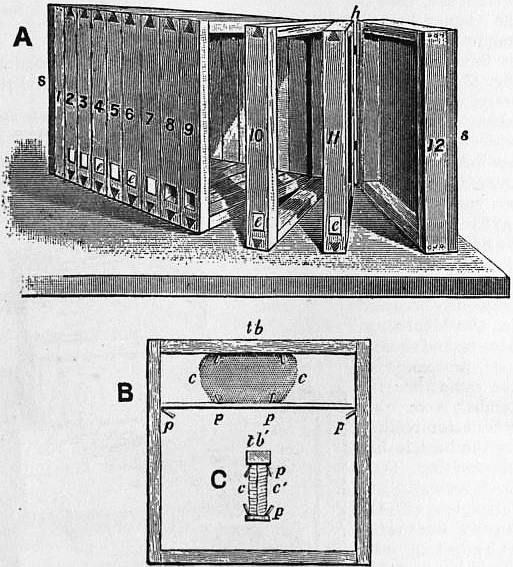 |
||
| Fig. 12.—Huber’s book or leaf hive. | ||
A, Book hive. e, e, Entrances. s, s, Side leaves. h, Hinges. |
B, Side view of frame or leaf. tb, Top-bar c, Comb. p, p, Pegs. |
C, Part of bin, cross section, lettering as before. |
| (From Cheshire’s Bees and Bee-keeping, Scientific and Practical.) | ||
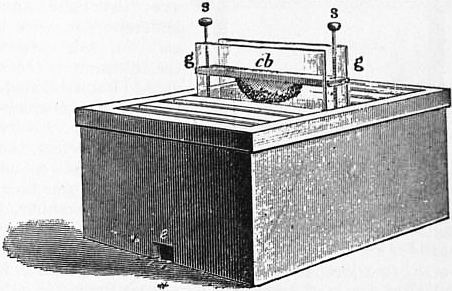 |
| Fig. 13.—Huber’s bar-hive, showing how comb is built, cb, Comb bar; g, g, glass sheets; s, s, screws; e, entrance |
| (From Cheshire’s Bees and Bee-keeping, Scientific and Practical.) |
About the same time the Rev. L.L. Langstroth was experimenting on the same lines in America, and in 1852 his important invention was made known, giving to the world of bee-keepers a movable frame which in its most important Laagstroth’s hive. details will never be excelled. We refer to the respective distances left between the side-bars and hive walls on each side, and between the lower edge of the bottom-bars and the floor-board. Langstroth, in his measurements, hit upon the happy mean which keeps bees from propolizing or fastening the frames to the hive body, as they assuredly would do if sufficient space had not been allowed for free passage round the side-bars; it is equally certain that if too much space had been provided, they would fill it with comb and thus render the frame immovable. In addition to these benefits, Langstroth’s frame and hive possessed the enormous advantage over Dzierzon’s of being manipulated from above, so that any single frame could be raised for inspection without disturbing the others. Langstroth’s space-measurements have remained practically unaltered notwithstanding the many improvements in hive-making, and in the various sizes of movable frames, since introduced and used in different parts of the world.
In the United States of America Langstroth’s frame and hive are the acknowledged “standards” among the great body of bee-keepers, although about a dozen different frames, varying more or less in size, have their adherents. Size of frames in the U.S.A. Among these may be named the American, Adair, Danzenbaker, Gallup, Heddon, Langstroth and Quinby. Three of these, the American, Adair and Gallup, may be termed square frames, the others being oblong, but the latter shape appears to possess the most all-round advantages to the modern bee-keeper. Amid the different climatic conditions of so vast a continent as America, variation in size, and in the capacity of frames used, is in some measure accounted for.
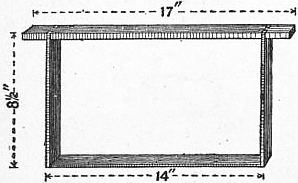 |
| Fig. 14.—Standard Frame. |
In the British Isles, though the conditions are variable enough, they are less extreme, and, fortunately for those engaged in the pursuit, only one size of frame is acknowledged by the great majority of bee-keepers, viz. the British British “Standard” frame. Bee-keepers’ Association “Standard” (fig. 14). This frame, the outside measurement of which is 14 by 8½ in., was the outcome of deliberations extending over a considerable time on the part of a committee of well-known bee-keepers, specially appointed in 1882 to consider the matter. In this way, whatever type or form of hive is used, the frames are interchangeable. Differences in view may, and do, exist regarding the thickness of the wood used in frame-making, but the outside measurement never varies. Notwithstanding this fact, the advancement of apiculture and the continuous development of the modern frame-hive and methods of working have proceeded with such rapidity, both in England and in America, that hives and appliances used prior to 1885 are now obsolete.
 |
| Fig. 15.—Langstroth Hive. |
| (Redrawn from the A B C of Bee-Culture, published by the A. I. Root Co., Medina, Ohio, U.S.A.) |
It may, therefore, be useful to compare the progress made in the United States of America and in Great Britain in order to show that, while the industry is incomparably larger and of more importance in America and Canada than in Great Britain, British bee-keepers have been abreast of the times in all things apicultural. The original Langstroth hive was single-walled, held ten frames (size 17¾ by 9 in.), and had a deep roof, made to cover a case of small honey boxes like the sections now in use; but the cumbersome projecting porch and sides, made to support the roof, are now dispensed with, and the number of frames reduced to eight. Although various modifications have since been made in minor details—all tending to improvement— its main features are unaltered. The typical hive of America is the improved Langstroth (fig. 15), which has no other covering for the frame tops but a flat roof-board allowing ¼ in. space between the roof and top-bars for bees to pass from frame to frame. Consequently, on the roof being raised the bees can take wing if not prevented from doing so. This feature finds no favour with British bee-keepers, nevertheless the “improved Langstroth” is a useful and simple hive, moderate in price, and no doubt efficient, but not suitable for bees wintered on their summer stands, as nearly all hives are in Great Britain. American bee-keepers, Winter cellars for bees. therefore, find it necessary to provide underground cellars, into which the bees are carried in the fall of each year, remaining there till work begins in the following spring. Those among them who cannot, for various reasons, adopt the cellar-wintering plan are obliged to provide what are termed “chaff-covers” for protecting their bees in winter. Of late years they have also introduced, as an improvement, the plan long followed in England of using double-walled chaff-packed hives. The difference here is that packing is now dispensed with, it being found that bees winter equally well with an outer case giving 1½ in. of free space on all sides of the hive proper, but with no packing in between. Thus no change is needed in winter or summer, the air-space protecting the bees from cold in winter and heat in summer. Another point of difference between the English and American hive is the roof, which being gable-shaped in the former allows warm packing to be placed directly on the frame tops, so that the bees are covered in when the roof is removed and may be examined or fed with very little disturbance. Again, the American hive is, as a general rule, set close down on the ground, while stands or short legs are invariably used in Great Britain. One of the best-known hives in England is that known as the W.B.C. hive, devised in 1890 by W. Broughton Carr.
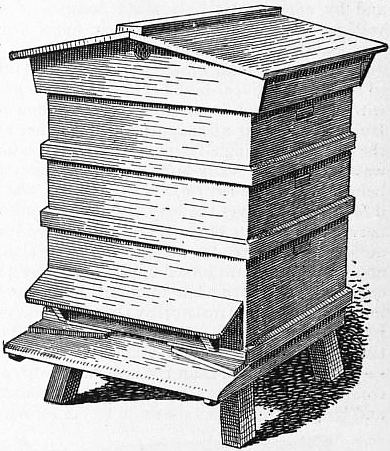 |
| Fig. 16.—Exterior, W.B.C. Hive. |
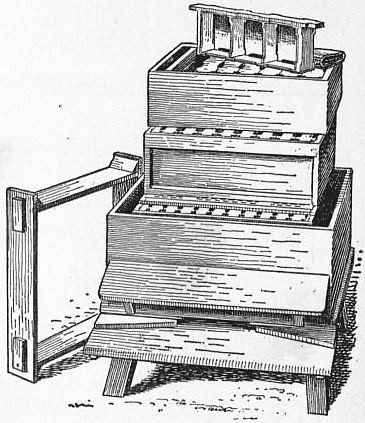 |
| Fig. 17.—Interior, W.B.C. Hive. |
Figs. 16 and 17 explain its construction and, as will be seen, it is equally suitable when working for comb or for extracted honey.
Various causes have contributed to the development of the modern hive, the most important of which are the improvements in methods of extracting honey from combs, and in the manufacture of comb-foundation. Regarding the first of these, it cannot be said that the honey extractor, even in its latest form, differs very much from the original machine (fig. 18) invented by Major Hruschka, an officer in the Italian army, who in later life became an enthusiastic apiculturist. Honey extractors. Hruschka’s extractor, first brought to public notice in 1865, may be said to have revolutionized the bee-industry as a business. It enabled the honey producer to increase his output considerably by extracting honey from the cells in most cleanly fashion without damaging the combs, and in a fraction of the time previously occupied in the draining, heating and squeezing process. At the same time the combs were preserved for refilling by the bees, in lieu of melting them down for wax. The principle of the honey extractor (throwing the liquid honey out of the cells by centrifugal force) was discovered quite by accident. Major Hruschka’s little son chanced to have in his hand a bit of unsealed comb-honey in a basket to which was attached a piece of string, and, as the boy playfully whirled the basket round in the air, his father noticed a few drops of honey, thrown out of the comb by the centrifugal force employed to keep the basket suspended. The value of the idea at once struck him, he set to work on utilizing the principle involved, and ere long had constructed a machine admirably adapted to serve its purpose. Since that time changes, of more or less value, have been introduced to meet present-day requirements. One of the first to take advantage of Hruschka’s invention was Mr A. I. Root, who in 1869 perfected a machine on similar lines to the Hruschka one but embodying various improvements. This appliance, known as the “Novice Honey Extractor,” became very popular in the United States of America, but it had the fault of wasting time in removing the combs for reversing after one side had been emptied of its contents. A simple form of machine for extracting honey by centrifugal force was brought to notice in England in 1875, and was soon improved upon, as will be seen in fig. 19, which shows a section of one of the best English machines at that time. Various plans were tried in America to improve on the “Novice” machine, and Mr T.W. Cowan, who was experimenting in the same direction in England, invented in the year 1875 a machine called the “Rapid,” in which, the combs were reversed without removal of the cages (fig. 20). The frame-cases—wired on both sides—are hung at the angles of a revolving ring of iron, and the reversing process is so simple and effective that the “Cowan” reversible frame has been adopted in all the best machines both in Great Britain and in America.
 |
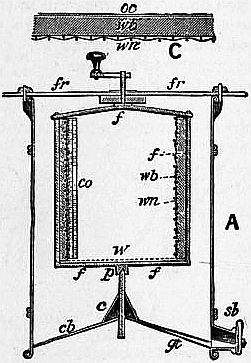 |
| Fig. 18.—Hruschka Extractor. | Fig. 19.—Diagram of the Raynor Extractor. |
| Redrawn from The A B C of Bee Culture, published by the A. I. Root Co, Medina, Ohio, U.S.A.) | A, Section of extractor. fr, Fixing rail ffr, Frame for cage. wb, Metal webbing. wn, Wire netting. co, Comb w, Wire bottom. p, Pivot. c, Stiffening cone. cb, Coned bottom. gt, Gutter. st, Syrup tap. C, Perpendicular section of side of cage enlarged. oc, Outer casing wb, Metal webbing wn, Wire netting |
| (From Cheshire’s Bees and Bee keeping, Scientific and Practical.) |
The latest form of honey extractor used in America is that known as the “Four-frame Cowan.” Fig. 21 shows the working part or inside of the appliance. In this, and indeed in all extractors used in large apiaries, the “Cowan” or reversible frame principle is used. Each of the four cages in which the combs are placed is swung on a pivot attached to the side, and when the outer faces of the combs are emptied the cages are reversed without removal from the machine for emptying the opposite sides of combs. The further development of the honey extractor has of late been limited to an increase in the size of machine used, in order to save time and manual labour, and thus meet the requirements of the largest honey producers, who extract honey by the car load. Some of the largest machines—propelled by motor power—are capable of taking eight or more frames at one time. It may also be claimed for the honey extractor that it does away with the objection entertained by many persons to the use of honey, by enabling the apiarist to remove his produce from the honey-combs in its purest form untainted by crushed brood and untouched by hand.
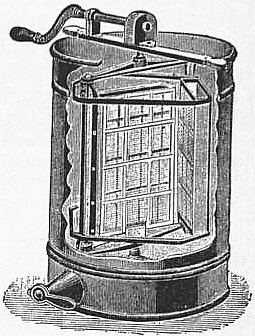 |
| Fig. 20.—Cowan’s rapid Extractor. |
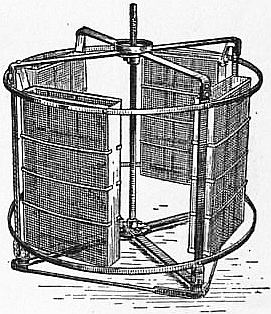 |
| Fig. 21.—Cowan’s four-frame Extractor; interior. |
| (Redrawn from The A B C of Bee Culture, published by the A. I. Root Co, Medina, Ohio, U.S.A.) |
Next in importance, to bee-keepers, is the enormous advance made in late years through the invention of a machine for manufacturing the impressed wax sheets known as “comb foundation,” aptly so named, because upon Comb foundation. it the bees build the cells wherein they store their food. We need not dwell upon the evolution from the crude idea, which first took form in the endeavour to compel bees to build straight combs in a given direction by offering them a guiding line of wax along the under side of each top-bar of the frame in which the combs were built; but we may glance at the more important improvements which gradually developed as time went on. In 1843 a German bee-keeper, Krechner by name, conceived the idea of first dipping fine linen into molten wax, then pressing the sheets so made between rollers, and thus forming a waxen midrib on which the bees would build their combs. This experiment was partially successful, but the instinctive dislike of bees to anything of a fibrous nature caused them completely to spoil their work of comb-building in the endeavour to tear or gnaw away the linen threads whenever they got in touch with them. In 1857 Mehring (also a German) made a further advance by the use of wooden moulds for casting sheets of wax impressed with the hexagonal form of the bee-cell. These sheets were readily accepted by the bees, and afterwards plates cast from metal were employed, with so good a result as to give to the bees as perfect a midrib as that of natural comb with the deep cell walls cut away. Fig. 22 shows a portion of one of these metal plates with worker-cells of natural size, i.e. five cells to the inch. Thus Mehring is justly claimed as the originator of comb-foundation, though the value of his invention was less eagerly taken advantage of even in Germany than its merits deserved. Probably it was ahead of the times, for not until nearly twenty years later was any prominence given to it, when Samuel Wagner, founder and editor of the American Bee Journal, became impressed with Mehring’s invention and warmly advocated it in his paper. Mr Wagner first conceived the idea of adding slightly raised side walls to the hexagonal outlines of the cells, by means of which the bees are supplied with the material for building out one-half or more of the complete cell walls or sides. The manifest advantage of this was at once realized by practical American apiarists as saving labour to the bees and money to the bee-keeper. One of the first to recognize its value was Mr A I. Root, of Medina, Ohio, who suggested the substitution of embossed rollers in lieu of flat plates, in order to increase the output of foundation and lessen its cost to the bee-keeper. He lost no time in giving practical shape to his views, and mainly through the inventive genius of a skilled machinist (Mr A. Washburn) the A. I. Root Co. constructed a roller press (fig 23) for producing foundation in sheets. This form of machine came into extensive use in the United States of America and afterwards in Great Britain. The first roller press was made by the A.I. Root Co. and imported by Mr William Raitt, a Scottish bee-keeper of repute in Perthshire, N.B. In all roller machines used at that time the plain sheets of wax were first made by the “dipping” process, i.e. by repeated dippings of damped boards in molten wax (kept in liquid condition in tanks immersed in hot water) until the sheet was of suitable thickness for the purpose. The prepared sheets were then passed through the rollers, and after being cut out and trimmed were ready for use.
 |
| Fig. 22.—Portion of a type-metal plate—i.e. form of Comb Midrib (five cells to the inch). |
| (From Cheshire’s Bees and Bee-keeping Scientific and Practical.) |
Owing to the enormous demand for comb-foundation at that time various devices were tried with the view of securing (1) more rapid production, and (2) a foundation thin enough to be used in surplus chambers when working for comb-honey intended for table use. Foremost among the able men who experimented in this latter direction was Mr F.B. Weed, a skilful American machinist, who, after some years of strenuous effort, succeeded in devising and perfecting special rollers and dies, by the use of which foundation was produced with a midrib so thin as to compare favourably with natural comb built by the bees. “Dipping,” however, proved not only a stumbling-block to speed but to the production of continuous sheets of wax; and in the end Mr Weed, acting in concert with Mr A.I. Root (who placed the resources of his enormous factory at his disposal), devised and perfected machinery—driven by motor power—for manufacturing foundation by what is known as the “Weed” process. By this process “dipping” is abolished, and in its latest form sheets of wax of any length are produced, passed between engraved rollers 6 in in diameter, cut to given lengths, trimmed, counted and paper-tissued ready for packing, at a rate of speed previously undreamt of.
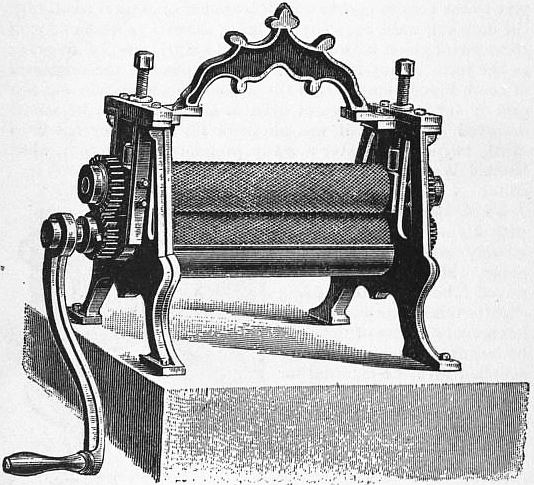 |
| Fig. 23.—Foundation Machine. |
| (From Cheshire’s Bees and Bee-keeping, Scientific and Practical.) |
Practical Management of Bees.—Among the world of insects the honey-bee stands pre-eminent as the most serviceable to mankind; from the day on which the little labourer leaves its home for the first time in search of food, its mission is undoubtedly useful. Launched upon an unknown world, and guided by unerring instinct to the very flowers it seeks, the bee fertilizes fruit and flowers while winging its happy flight among the blossoms, gathering pollen for the nurslings of its own home and honey for the use of man. Nothing seems to be lost, nor can any part of the bee’s work be accounted labour in vain; the very wax from which the insect builds the store-combs for its food and the cells in which its young are hatched and reared is valuable to mankind in many ways, and is regarded today no less than in the past ages as an important commercial product. The hive bee is, moreover, the only insect known to be capable of domestication, so far as labouring under the direct control of the bee-master is concerned, its habits being admirably adapted for embodying human methods of working for profit in our present-day life.
In dealing with the practical side of apiculture it will not be necessary to do more than mention the salient points to be considered by those desirous of acquiring more complete knowledge of the subject. Authoritative text-books specially written for the guidance of bee-keepers are numerous and cheap, and on no account should any one engage in an attempt to manage bees on modern lines without a careful perusal of one or more of these. Bearing this in mind the reader will understand that so much of the natural history of the honey-bee as is necessary for elucidating the practical part of our subject may be comprised in (1) the life of the insect, (2) its mission in life, and (3) utilizing to the utmost the brief period during which it can labour before being worn out with toil.
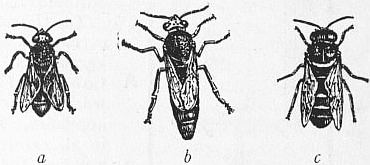 |
| Fig. 24.—Hive bee (Apis mellafica). a, Worker; b, queen; c, drone. |
| (From Cheshire’s Bees and Bee-keeping, Scientific and Practical.) |
A prosperous bee-colony managed on modern lines will in the height of summer consist of three kinds of bees: a queen or mother-bee, a certain number of drones, and from 80,000 to 100,000 workers. With regard to sex, the Sex of bees. queen is a fully-developed female, the drones are males and the workers may be termed neuters or partially developed females. These last possess ovaries like the queen, but shrunken and aborted so as to render the insect normally incapable of egg-production. The relative importance of the three kinds of bees, differs greatly in a degree and in somewhat curious fashion. For instance, the queen (or “king” of the hives as it was termed by our forefathers) is of paramount importance at certain Loss of queens. seasons, her death or disablement during the period when the male element is absent meaning extinction of the whole colony. Fecundation would under such conditions be impossible, and without this the eggs of a resultant queen will produce nothing but drones. During the summer season, however (from May to July), when drones are abundant, the loss of a queen is of comparatively little moment, as the workers can transform eggs (or young larvae not more than three days old), which would in the ordinary course produce worker bees, into fully-developed queens, capable of fulfilling all the maternal duties of a mother-bee. The value of this wonderful provision of nature to the bee-keeper of today may be estimated from the fact that bees managed according to modern methods are necessarily subject to so much manipulating or handling, that fatal accidents are as likely to happen in bee life as among human beings.
Authorities differ with regard to the age during which the queen bee is useful to the bee-keeper who works for profit. Under normal conditions the insect will live for three, four or sometimes five years, but the stimulation given together with the high-pressure system followed in modern bee-management, exhausts the period of her greatest fecundity in two years, so that queens are usually superseded after their second season has expired and egg-production gradually decreases. This can hardly cause wonder if it is borne in mind that for many weeks during the height of the season a prolific queen will deposit eggs at the rate of from two to three thousand every twenty-four hours.
Drones (or male bees) are more or less numerous in hives according to the skill of the bee-keeper in limiting their production. It is admitted by those best able to judge that the proportion of about a hundred drones in each The drone. hive is conducive to the prosperity of the colony, but beyond that number they are worse than useless, being non-producers and heavy consumers. Thus in times of scarcity, which are not infrequent during the early part of the season, they become a heavy tax upon the food-supply of the colony at the critical period when brood-rearing is accelerated by an abundance of stores, while shortness of food means a falling-off in egg-production. The modern bee-keeper, therefore, allows just so much drone comb in the hive as will produce a sufficient number of drones to ensure queen-mating, while affording to the bees the satisfaction of dwelling in a home equipped according to natural conditions, and containing all the elements necessary to bee-life. The action of the bees themselves makes this point clear, for when the season of mating is past the drone is no longer needed, the providing of winter stores taking first place in the economy of the hive. So long as honey is being gathered in plenty drones are tolerated, but no sooner does the honey harvest show signs of being over than they are mercilessly killed and cast out of the hive by the workers, after a brief idle life of about four months’ duration. Thus the “lazy yawning drone,” as Shakespeare puts it, has a short shrift when his usefulness to the community is ended.
Finally we have the aptly named worker-bee, on whom devolves the entire labour of the colony. The worker-bee is incapable of egg-production and can therefore take no part in the perpetuation of its species, so that individually its The worker-bee. value to the community is infinitesimal. Yet it forms an item in a commonwealth, the members of which are in all respects equally well endowed. They are in turn skilled scientists, architects, builders, artisans, labourers and even scavengers; but collectively they are the rulers on whom the colony depends for the wonderful condition of law and order which has made the bee-community a model of good government for all mankind. Then so far as regards longevity, the period Longevity in bees. of a worker-bee’s existence is not measured by numbering its days but simply by wear and tear, the marvellous intricacy and wonderful perfection of its framework being so delicate in construction that after six or seven weeks of strenuous toil, such as the bee undergoes in summer time, the little creature’s labour is ended by a natural death. On the other hand, worker-bees hatched in the autumn will seven months later be strong with the vigour of lusty youth, able to take their full share in the labour of the hive for six weeks or more in the early spring, which is the most critical period in the colony’s existence; hence the value to the apiarist of bees hatched in the autumn.
The mission of the worker-bee is work; not so much for itself as for the younger members of the community to which it belongs. We cannot claim for it the virtue of strict honesty with regard to the stranger, but for its own “kith and kin” it is a model of socialism in an ideal form, possessing nothing of its own yet toiling unceasingly for the good of all. The increasing warmth of each recurring spring finds the bee awake, and full of eagerness to be up and doing; its sole mission being apparently to accomplish as much work as possible while life lasts. The earliest pollen is sought out from far and near, and has its immediate effect upon the mother bee of the colony. If healthy and young she begins egg-laying at once, and brood-rearing proceeds at an ever-increasing rate as each week passes, until the hive is brimming over with bees in time for the first honey flow. Then comes the almost human foresight with which the bee prevents the inevitable chaos created by an overcrowded home. There is no cell-room either for storing the abundant supply of food constantly being brought in, or for the thousands of eggs which a prolific queen will produce daily as a consequence of general prosperity; therefore unless help comes from without an exodus is prepared for, and what is known as “swarming” takes place.
It would be difficult to imagine anything more exhilarating to a beginner in bee-keeping than the sight of his first hive in the act of swarming. The little creatures are seen rushing in frantic haste from the hive like a living Swarming. stream, filling the air with ever-increasing thousands of bees on the wing. The incoming workers returning pollen-laden from the fields, carried away by the prevailing excitement, do not stop to unload their burdens in the old home, but join the enthusiastic emigrants, tumbling over each other pell-mell in the outrush; among them the queen of the colony will in due course have taken her place, bound like her children for a new home. It soon becomes apparent to the onlooker when the queen has joined the flying multitude of bees in the air, for they are seen to be closing up their ranks, and in a few moments begin to form a solid cluster, usually on the branch of a small tree or bush close to the ground. When this stage of swarming is reached the bee-keeper has but to take his hiving skep, hold it under the swarm, and shake the bees into it, preparatory to transferring Hiving swarms. them into a frame-hive already prepared for their reception. The process of hiving a swarm is very simple and need not occupy many moments of time under ordinary conditions, but so many unlooked-for contingencies may arise that the apiarist would do well to prepare himself beforehand by carefully reading the directions in his text-book.
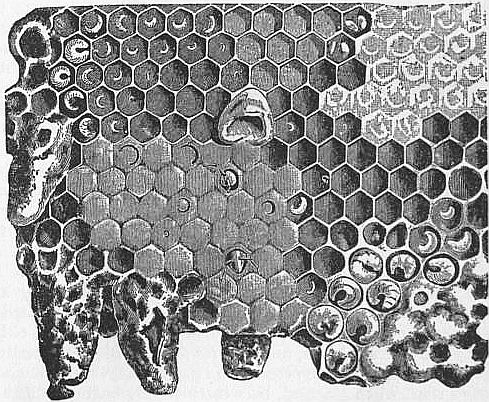 |
| Fig. 25.—Honeycomb, Metamorphoses of the Honey Bee. |
| (From Cheshire’s Bees and Bee-keeping, Scientific and Practical.) |
The illustration given in fig. 25 will serve more readily than words to enlighten the would-be bee-keeper. It shows a portion of honeycomb (natural size) not precisely as it appears when the frame containing it is lifted out of the hive, but as would be seen on two or more combs in the same hive, namely, the various cells built for—and occupied by—queens, drones and workers; also the larvae or grubs in the various stages of transformation from egg to perfect insect, with the latter biting their way out of sealed cells. It also shows sealed honey and pollen in cells, &c. To familiarize himself with the various objects depicted, all of which are drawn from nature, will not only help the reader to understand the different phases of bee-life during the swarming season, but tend to increase the interest of beginners in the pursuit. “Early drones, early swarms” was the ancient bee-man’s favourite adage, and the skilled apiarist of to-day experiences the same pleasurable thrill as did the skeppist of old at the sight of the first drone of the year, which betokens an early swarm. As the drones increase in number queen-cells are formed, unless steps be taken to turn aside the swarming impulse by affording additional room beforehand in the hive. The above brief outline of the guiding principles of natural swarming is merely intended as introductory to the fuller information given in a good text-book.
Management of an Apiary.—The main consideration in establishing an apiary is to secure a favourable location, which means a place where honey of good marketable quality may be gathered from the bee-forage growing around without any planting on the part of the bee-keeper himself. It is impossible to deal here with the varying conditions under which apiculture is carried on in all parts of the world, but, as a rule, the same principle applies everywhere. The bee industry prospers greatly Bee-forage in U.S.A. in America, where amid the vast stretches of mountain and canyon in California the bee-forage extends for miles without a break, and the climatic conditions are so generally favourable as to reduce to a minimum the chances of the honey crop failing through adverse weather.
The bee-keeper’s object is to utilize to the utmost the brief space of a worker-bee’s life in summer, by adopting the best methods in vogue for building up stocks to full strength before the honey-gathering time begins, and preparing for it by the exercise of skill and intelligence in carrying out this work.
In the United Kingdom there is a difference of several weeks in the honey season between north and south. Swarming usually begins in May in the south of England, and in mid-July in the north of Scotland, the issue of swarms coinciding with the early part of the main honey flow. The weather is naturally more precarious in autumn than earlier in the year, and chances of success proportionately smaller for northern bee-men, but the disadvantage to the latter is more than compensated for by the heather season, which extends well into September. With regard to the British bee-keeper located in the south, Value of pollen. the early fruit crop is what concerns him most, and where pollen (the fertilizing dust of flowers) is plentiful his bees will make steady progress. If pollen is scarce, a substitute in the form of either pea-meal or wheaten flour must be supplied to the bees, as brood-rearing cannot make headway without the nitrogenous element indispensable in the food on which the young are reared. But the main honey-crop of both north and south is gathered from the various trifoliums, The queen of bee-plants. among which the white Dutch or common clover (Trifolium repens) is acknowledged to be the most important honey-producing plant wherever it grows. In the United States, Canada, Australia, New Zealand and in many other parts of the world honey of the finest quality is obtained from this “queen of bee-plants,” and in lesser degree from other clovers such as sainfoin, alsike (a hybrid clover), trefoil, &c.
Before undertaking the management of a modern apiary, the bee-keeper should possess a certain amount of aptitude for the pursuit, without which it is hardly possible to succeed. He must also acquire the ability to handle bees judiciously and well under all imaginable conditions. In doing this it is needful to remember that bees resent outside interference with either their work or their hives, and will resolutely defend themselves when aroused even at the cost of life itself. Experience has also proved that, when alarmed, bees instinctively begin to fill their honey-sacs with food from the nearest store-cells as a safeguard against contingencies, and when so provided they are more amenable to interference. The bee-keeper, therefore, by the judicious application of a little smoke from smouldering fuel, blown into the hive by means of an appliance known as a bee-smoker, alarms the bees and is thus able to manipulate the frames of comb with ease and almost no disturbance. The smoker (fig. 26) devised by T.F. Bingham of Farwell, Michigan, U.S.A., is the one most used in America and in the United Kingdom. No other protection is needed beyond a bee-veil of fine black net, which slipped over a wide-brimmed straw hat protects the face from stings when working among bees; as experience is gained the veil is not always used. The man who is hasty and nervous in temperament, who fears an occasional sting, and resents the same by viciously killing the bee that inflicts it will rarely make a good apiarist. The methods of handling bees vary in different countries, this being in a great measure accounted for by the number of hives kept. Very few apiaries in the United Kingdom contain more than a hundred hives; consequently the British bee-keeper has no need for employing the forceful or “hustling” methods found necessary in America, British and American methods. where the honey-crop is gathered in car-loads and the hives numbered by thousands. It naturally follows that bee-life is there regarded very slightly by comparison, and the bee-garden in England becomes the “bee-yard” in America, where the apiarist when at work must thoroughly protect himself from being stung, and, safe in his immunity from damage, cares little for bee-life in getting through his task, the loss of a few hundred bees being considered of no account. There are, however, other reasons, apart from humanity, to account for the difference in handling bees as advocated in the United Kingdom. The great majority of apiaries owned by British bee-keepers are located in close proximity to neighbours; consequently a serious upset among the bees would in many cases involve an amount of trouble which should if possible be avoided; therefore quietness and the exercise of care when manipulating are always recommended by teachers, and practised by those who wisely take their lessons to heart.
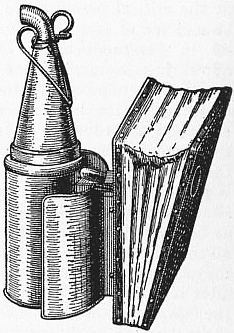 |
| Fig. 26.—Bee-Smoker. |
| (Redrawn from the A B C of Bee-Culture, published by the A.I. Root Co, Medina, Ohio, U.S.A.) |
Having made himself proficient in practical bee-work and chosen a suitable location for his apiary, the bee-keeper should carefully select the particular type of hive most suited to his means and requirements. This point settled, uniformity is Chosing a location. secured, and all loose parts of the hives being interchangeable time will be saved during the busy season when time means money. Beginning with not too many stocks he can test the capabilities of his location before investing much capital in the undertaking, so that by utilizing the information already given and adopting the wise adage “make haste slowly” he will realize in good time whether it will pay best to work for honey in comb or extracted honey in bulk; not only so, but the knowledge gained will enable him to select such appliances as are suited to his needs. As a rule, Bee-keeping for profit. it may be said that the man content to start with an apiary of moderate size—say fifty stocks—may realize a fair profit from comb-honey only; but so limited a venture would need to be supplemented by some other means before an adequate income could be secured. On the other hand, the owner of one or two hundred colonies would find it more lucrative to work for extracted honey and send it out to wholesale buyers in that form. By so doing a far greater weight of surplus per hive may be secured, and extracted honey will keep in good condition for years, while comb-honey must be sold before granulation sets in. At the same time it is but fair to say that bee-culture in the United Kingdom, if limited to honey-production alone, is not sufficiently safe for entire reliance to be placed on it for obtaining a livelihood. The uncertain climate renders it necessary to include either other branches of the craft less dependent on warmth and sunshine, or to combine it with fruit-growing, poultry-rearing, &c. Under such conditions the bees will usually occupy a good position in the balance-sheet.
Another indispensable feature of good bee-management is “forethought,” coupled with order and neatness; the rule of “a place for everything and everything in its place” prepares the bee-keeper for any emergency; constant watchfulness is Need of forethought. also necessary, not only to guard against disease in his hives, but to overlook nothing that tends to be of advantage to the bees at all seasons. Among the many ways of saving time nothing is more useful than a carefully-kept note-book, wherein are recorded brief memoranda regarding such items as condition of each stock when packed for winter, amount of stores, age and prolific capacity of queen, strength of colony, healthiness or otherwise, &c., all of which particulars should be noted and the hives to which they refer plainly numbered. It also enables the bee-keeper to arrange his day’s work indoors while avoiding disturbance to such colonies as do not need interference. In the early spring stores must be seen to and replenished where required; breeding stimulated when pollen begins to be gathered, and appliances cleaned and prepared for use during the busy season.
The main honey-gathering time (lasting about six or seven weeks) is so brief that in no pursuit is it more important to “make hay while the sun shines,” and if the bee-keeper needs a reminder of this truism he surely has it in the Length of bee season. example set by his bees. As the season advances and the flowers yield nectar more freely, visible signs of comb-building will be observed in the whitened edges of empty cells in the brood-chambers; the thoughtful workers are lengthening out the cells for honey-storing, and the bee-master takes the hint by giving room in advance, thus lessening the chance of undesired swarms. In other words, order and method, combined with the habit of taking time by the forelock, are absolutely necessary to the bee-keeper, seeing that the enormous army of workers under his control is multiplying daily by scores of thousands. As spring merges into summer, sunny days become more frequent; the ever-increasing breadth of bee-forage yields still more abundantly, and the excitement among the labourers crowding the hives increases, rendering room in advance, shade and ventilation, a sine qua non. It requires a level head to keep cool amongst a couple of hundred strong stocks of bees on a hot summer’s day in a good honey season. Swarm prevention. Moreover, it will be too late to think of giving ventilation at noontide, when the temperature has risen to 80° F. in the shade; the necessary precautions for swarm prevention must therefore be taken in advance, for when what is known as the “swarming fever” once starts it is most difficult to overcome.
The well-read and intelligent bee-keeper, content to work on orthodox lines, will be able to manage an apiary—large or small—by guiding and controlling the countless army he commands in a way that will yield him both pleasure and profit. All he needs is good bee weather and an apiary free from disease to make him appreciate bee-craft as one of the most remunerative of rural industries; affording a wholesome open-air life conducive to good health and yielding an abundance of contentment.
Diseases of Bees.—It is quite natural that bees living in colonies should be subject to diseases, and only since the introduction of movable-comb hives has it been possible to learn something about these ailments. The most serious disease with which the bee-keeper has to contend is that commonly known as “bee-pest” or “foul brood,” so called because of the young brood dying and rotting in the cells. This disease has been known from the earliest ages, and is probably the same as that designated by Pliny as blapsigonia (Natural History, bk. xi. ch. xx.). Coming to later times, Della Rocca minutely describes a disease to which bees were subject in the island of Syra, between the years 1777 and 1780, and through which nearly every colony in the island perished. From the description given it was undoubtedly foul brood, and the bee-keepers of the island became convinced, after bitter experience, that it was extremely contagious. Schirach also mentioned and described the disease in 1769, and was the first to give it the name of “foul brood.” Still later, in 1874, Dr Cohn, after the most exhaustive experiments and bacteriological research, realized that the disease was caused by a bacillus, and—nine years later—the name Bacillus alvei was given to it by Cheyne and Cheshire, whose views were in agreement with those of Dr Cohn.
The illustration (fig. 27) shows a portion of comb affected with foul brood in its worst form. The sealed cells are dark-coloured and sunken, pierced with irregular holes, and the larvae in all stages from the crescent-shaped healthy condition to that in which the dead larvae are seen lying at the bottom of the cells, flaccid and shapeless. The remains then change to buff colour, afterwards turning brown, when decomposition sets in, and as the bacilli present in the dead larvae increase and the nutrient matter is consumed, the mass in some cases becomes sticky and ropy in character, making its removal impossible by the bees. In course of time it dries up, leaving nothing but a brown scale adhering to the bottom or side of the cell. In the worst cases the larvae even die after the cells are sealed over; a strong characteristic and offensive odour being developed in some phases of the disease, noticeable at times some distance away from the hive.
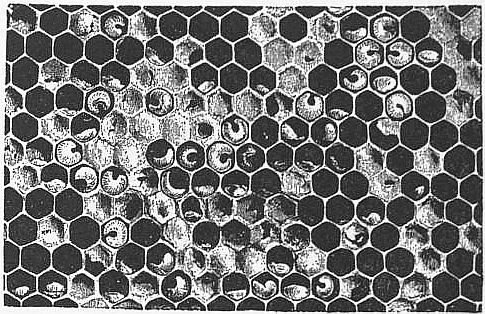 |
| Fig. 27.—Foul Brood (Bacillus alvei). |
| (From Cheshire’s Bees and Bee-keeping, Scientific and Practical.) |
Two forms of foul brood have been long known, one foul smelling, the other odourless; and investigations made during 1906 and 1907 showed that the etiology of the disease is not by any means simple, but that it is produced by different microbes, two others in addition to Bacillus alvei playing an important part. These are Bacillus brandenburgiensis, Maassen (syn. B. burri, Burri: B. larvae, white), and Streptococcus apis, Maassen (syn. B. Guntheri, Burri). The first two are found in both forms of foul brood, whereas the last is only present with B. alvei in the strong-smelling form of the disease, in which the larvae are attacked prior to the cells being sealed over.
The brood of bees, when healthy, lies in the combs in compact masses, the larvae being plump and of a pearly whiteness, and when quite young curled up on their sides at the base of the cells. When attacked by the disease, the larva moves uneasily, stretches itself out lengthwise in the cell, and finally becomes loose and flabby, an appearance which plainly indicates death.
When the disease attacks the larvae before they are sealed over Bacillus alvei is present, usually associated with Streptococcus apis, which latter imparts a sour smell to the dead brood. In cases where the disease is odourless the larvae are attacked after the cells are sealed over, and just before they change to pupae, when they become slimy, sputum-like masses, difficult to remove from the cells. Under these conditions Bacillus brandenburgiensis is found, although Bacillus alvei may also be present. The two bacilli are antagonistic, each striving for supremacy, first one then the other predominating. Various other microbes are also present in large numbers, but are not believed to be pathogenic or disease-producing in character.
It is, therefore, seen that at least three different microbes play an important part in the same disease. The danger of contagion lies in the wonderful vitality of the spores, and their great resistance to heat and cold. Dr Maassen records a case where he had no difficulty in obtaining cultures from spores removed from combs after being kept dry for twenty years. It should be borne in mind that the disease is much easier to cure in the earlier stages while the bacilli are still rod-shaped than when the rods have turned to spores.
Since the bacterial origin of foul brood has been established, the efforts of some bacteriologists have been employed in finding a simple remedy by means of which the disease may be checked in its earliest stages, and in this an appreciable amount of success has been attained. Nor has foul brood in its more advanced forms been neglected, all directions for treatment being found in text-books written by distinguished writers on apiculture in the United Kingdom, America and throughout the European continent.
The only other disease to which reference need be made here is dysentery, which sometimes breaks out after the long confinement bees are compelled to undergo during severe winters. This trouble may be guarded against by feeding the bees in the early autumn with good food made from cane sugar, and housing them in well-ventilated hives kept warm and dry by suitable coverings. When bees are wintered on thin, watery food not sealed over, and are unable for months to take cleansing flights, they become weak and involuntarily discharge their excrement over the combs and hive, a state of things never seen in a healthy colony under normal conditions. The stocks of bee-keepers who attend to the instructions given in text-books are rarely visited by this disease.
The above embraces all that is necessary to be said in relation to diseases, though bees have been subject to other ailments such as paralysis, constipation, &c.
In the Isle of Wight a serious epidemic broke out in 1906 which caused great destruction to bee-life in the following year. The malady was of an obscure character, but its cause has been under investigation by the British Board of Agriculture and Fisheries, and by European bacteriologists in 1908.
Authorities.—Though in modern times a great deal has appeared in the daily newspapers on the subject, it is a notable fact that not a tithe of the wonderful things published in such articles about bees and bee-keeping is worthy of credence or possesses any real value. Indeed, a pressman possessing any technical knowledge of the subject—beyond that obtainable from books—would be a rara avis. The account given above is the result of forty years’ practical experience with bees in England, the writer having for a great portion of the time been connected editorially with the only two papers in that country entirely devoted to bees and bee-keeping, The British Bee Journal (weekly, founded 1873), and Bee-keepers’ Record (monthly, founded 1882), the former being the only weekly journal in the world. The following books on the subject may be consulted for further details:—François Huber, New Observations on the Natural History of Bees; T.W. Cowan, British Bee-keepers’ Guide-Book, The Honey Bee, its Natural History, Anatomy and Physiology; Langstroth on the Honey Bee, revised by C. Dadant & Son; A.I. Root, A B C and X Y Z of Bee-culture; F.R. Cheshire, Bees and Bee-keeping; Dr Dzierzon, Rational Bee-keeping; E. Bertrand, Conduite du rucher; A.J. Cook, Manual of the Apiary; Dr C.C. Miller, Forty Years among the Bees; F.W.L. Sladen, Queen-rearing in England; S. Simmins, A Modern Bee Farm.


